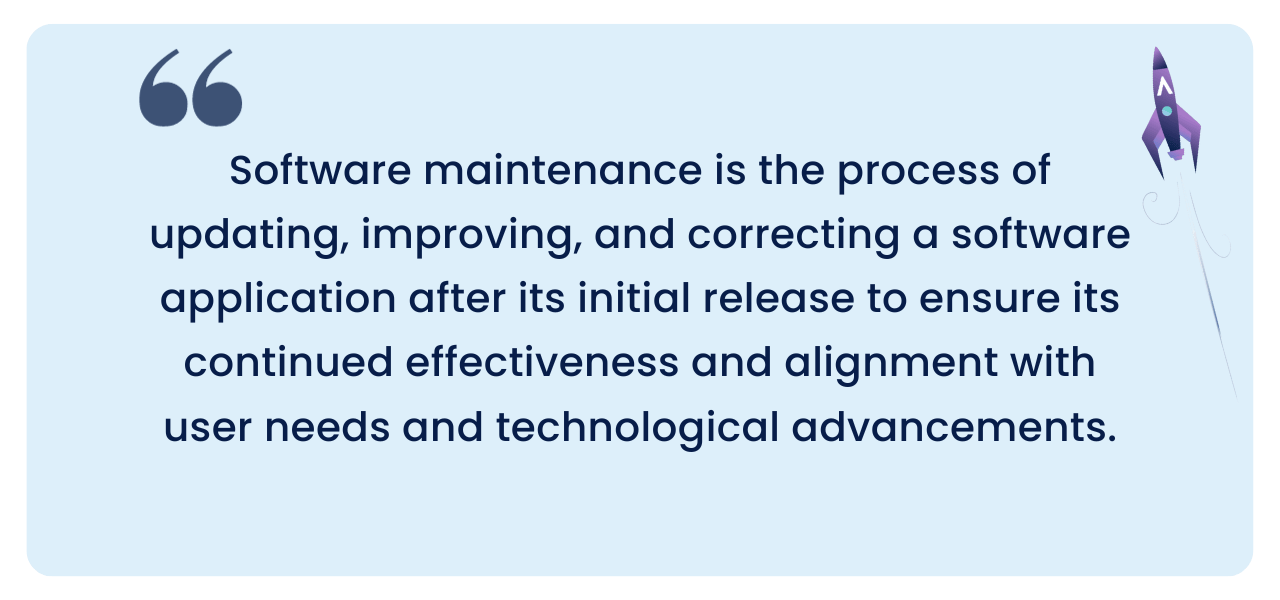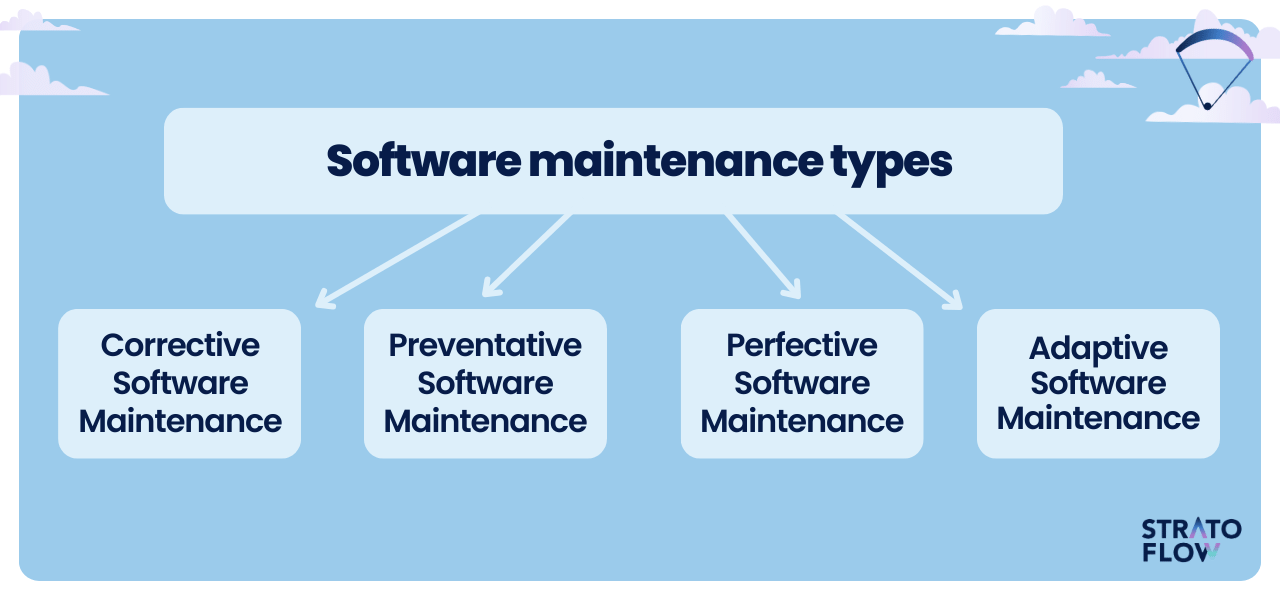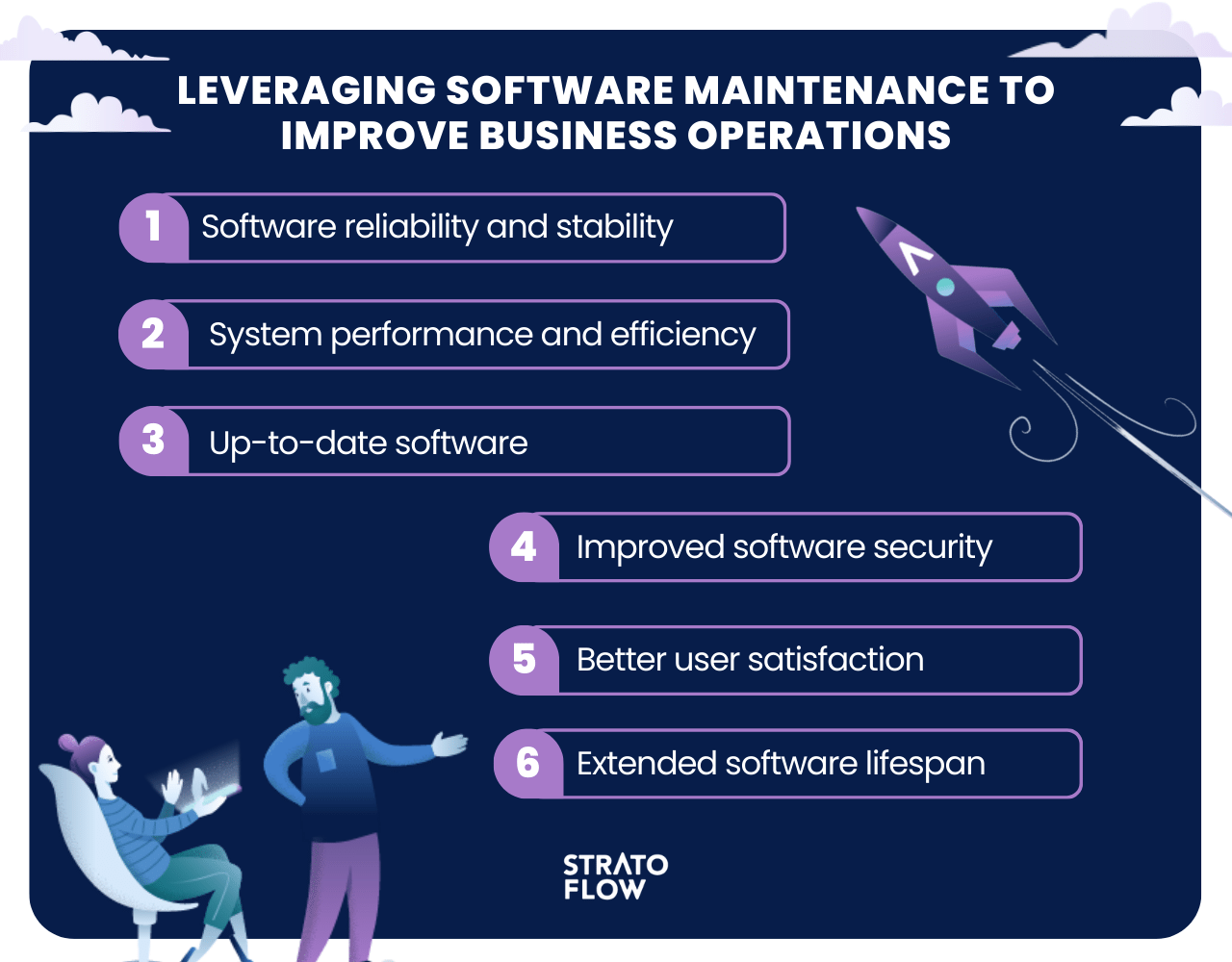
SDLC Guide: A Comprehensive Guide to Software Maintenance Phase
What exactly is software maintenance, and why should you care?
Simply put, it’s the practice of keeping your software running smoothly – mitigating risk, improving functionality, and ensuring longevity.
In this installment of our series on the SDLC, we take a deep dive into the world of software maintenance, detailing its types, processes, and strategic role in the software development process. You don’t want to miss this, because this phase has a huge impact on the total cost of software down the line!
Contents
- What is software maintenance and why it’s important?
- Key software maintenance types
- The costs of software maintenance
- Leveraging software maintenance to improve business operations
- Software maintenance in the Software Development Life Cycle (SDLC)
- Software maintenance: understanding and enhancing legacy systems
Key Takeaways
- Software maintenance is a critical process in the software lifecycle, vital for ensuring functionality, security, and reliability of software systems by addressing issues, enhancing performance, and adapting to changes.
- There are four primary types of software maintenance: Corrective, Preventive, Perfective, and Adaptive, each dealing with different aspects of keeping a software system updated and functioning optimally in various environments.
- The process of software maintenance includes a series of essential steps: Problem Identification and Analysis, Design, Implementation and Testing, Deployment and Monitoring, and Continuous Improvement.
What is software maintenance and why it’s important?
Software maintenance is a critical part of the software lifecycle, essential to keeping software effective and up-to-date after it’s initially released.
Proper software maintenance involves various tasks, such as fixing bugs – those unexpected errors that occur – and ensuring that the software remains secure against new types of cyber threats. This process isn’t just about fixing what’s broken; it’s also about making improvements, such as adding new features that users need or making the software run faster and more smoothly.

What makes software maintenance essential?
Imagine a world where software issues are not addressed promptly, resulting in slow performance, security vulnerabilities, or even total system failure. Software maintenance not only improves the functionality of software, it also plays a critical role in maintaining software security and reducing downtime.
For enterprises, software maintenance is key to ensuring that software continues to meet customer needs, remains compatible with other technologies, and complies with regulatory requirements.
These ongoing efforts help organizations maintain a competitive edge and ensure that their software investments continue to pay off over the long term.
Key software maintenance types
There are four primary types of software maintenance, and understanding each one is key to ensuring the longevity and effectiveness of software: Corrective, Preventive, Perfective, and Adaptive. They all play an essential role in maintaining software systems.

Corrective Software Maintenance: Bug fixing and fault resolution
Corrective software maintenance is primarily focused on identifying and correcting errors in software that are either reported by users or discovered through internal testing. This type of maintenance is reactive in nature, addressing problems such as bugs, system crashes, or functionality issues that affect user experience and operational efficiency.
You can think of corrective maintenance as a doctor’s visit for your software.
It’s about identifying and fixing bugs in the software system to ensure a smooth and efficient user experience. The question is, how do we find these bugs? Through extensive testing and rigorous quality control measures.
But finding the bugs is just the beginning. The next step is to fix them.
Corrective software maintenance also involves using debugging tools, analyzing error messages, and implementing standardized processes. This not only improves the user experience, but also increases user satisfaction.
Preventative Software Maintenance: Anticipating and preventing issues
Preventive software maintenance keeps you ahead of potential problems.
It involves taking proactive steps to reduce the likelihood of future software problems. It’s like getting regular check-ups to prevent diseases before they occur.
It includes tasks such as optimizing code, refining documentation, and updating systems to improve overall performance and maintainability. The goal is to anticipate and mitigate potential problems before they become problematic, thereby reducing the need for corrective maintenance.
From a business perspective, preventive maintenance is a strategic approach that can lead to long-term cost savings, improved system stability and extended software life, ensuring consistent and reliable operation.
Perfective Software Maintenance: Tuning for peak performance
The essence of perfect software maintenance is continuous improvement and enhancement. This type of maintenance focuses on enhancing and improving the software to meet evolving user needs and market demands.
Perfective maintenance is like upgrading your smartphone to the latest model – it’s not necessary, but it improves the user experience and keeps you on the cutting edge.
It includes adding new features, improving user interfaces, and optimizing software performance. Perfective software maintenance is driven by user feedback and business needs, and focuses on making the software more efficient, easier to use, and relevant in a competitive marketplace. This continuous improvement not only enhances the user experience, but also extends the useful life of software assets, ultimately leading to improved system performance.
Adaptive Software Maintenance: Keeping pace with change
In a world that’s constantly evolving, adaptive maintenance ensures that software keeps pace with change. Therefore, adaptive maintenance is concerned with keeping software compatible and up to date with the changing technological environment.
Adaptive software maintenance includes modifying the software to ensure that it works with new operating systems and hardware, or interacts with other updated software.
Adaptive maintenance is necessary to ensure that software remains functional and relevant in an ever-changing technological landscape.
Five Key steps of the software maintenance processes
Just like any other process, software maintenance involves a series of steps, each playing a critical part in the entire software process cycle.

Step 1: Problem Identification and Analysis
The first step in the software maintenance process is to identify the problem.
Like a doctor diagnosing an illness, software developers must identify the problems in the software that need to be addressed. This requires comprehensive testing methods and the establishment of software quality goals, which are integral parts of the software development process.
Following problem identification, the subsequent step entails analyzing them. This involves:
- Performing root cause analysis to uncover the underlying causes
- Scrutinizing data and identifying patterns
- Utilizing tools like flowcharts and cause-and-effect diagrams
This step is crucial in determining the best course of action for maintenance.
Step 2: Designing the Improvements
Design is the second step in the software maintenance process. It involves planning the solution to the identified problem, taking into account the current architecture of the software.
Software design, a critical aspect of software engineering, plays an important role in the maintenance process because it affects the quality, performance, and evolution of the software system. It’s also important to consider user experience in the design phase, as it can greatly improve usability and create visually appealing graphics.
Step 3: Implementation and Testing
Following the design phase, the next stage involves implementing the solution. This involves integrating new modules into the software and conducting comprehensive tests to ensure the solution works as intended.
However, merely implementing the solution doesn’t suffice. It’s also crucial to test it thoroughly to ensure it effectively resolves the identified issue. This involves comprehensive testing methods and analyzing potential issues that may arise over time.
Step 4: Deployment and Monitoring
Deployment and monitoring is the fourth stage of the software maintenance process. It involves deploying the updated software and monitoring its performance to ensure that the maintenance was successful.
Deployment must be performed with care to avoid adverse effects on system performance. After deployment, monitoring tools such as Dynatrace, Datadog, and Akamai mPulse are used to track software performance. Regular monitoring after software deployment is critical to ensure optimal performance.
Step 5: Continuous improvement
Continuous improvement signifies the final step in the software maintenance process. This involves regularly reviewing and updating the software to maintain optimal performance.
This is achieved by:
- Establishing clear objectives
- Prioritizing key processes or products
- Developing specific maintenance strategies
- Consistently evaluating and iterating the improvement process
Continuous improvement plays a crucial role in achieving optimal software performance by facilitating the adaptation to changing user requirements.
[Read also: How to Prepare for a Successful System Migration Project]
The costs of software maintenance
Software maintenance incurs additional expenses, which need to be accounted for in budget planning.
It is essential to consider the software maintenance cost implications to ensure financial preparedness. And while it can be high, it’s a necessary investment for ensuring software effectiveness, security, and reliability over time.
On average, software maintenance services constitute around 20-25% of the annual software development cost.
The cost of software maintenance is influenced by several factors such as:
- Program lifetime
- Dependence on external environment
- Hardware stability
- Complexity of the software system
- Size of the software system
- Change rate of the software system
Understanding these factors can help organizations better plan for and manage their software maintenance costs.
Leveraging software maintenance to improve business operations
Software maintenance is not just a technical necessity, but a strategic resource that can be leveraged to:
- Ensures software reliability and stability
- Improves system performance and efficiency
- Keeps the software up-to-date with technological advancements
- Enhances software security and protects against vulnerabilities
- Addresses user feedback and improves user satisfaction
- Extends the lifespan of the software

Keeping a software product up-to-date can optimize business operations by saving time on task completion, extending product life spans, boosting productivity, improving connectivity, and automating key functions. Moreover, software maintenance plays a crucial role in enhancing business security by regularly implementing security updates, patches, and bug fixes to mitigate potential threats.
By utilizing software maintenance strategies, businesses can gain a competitive advantage in the current dynamic market.
Software maintenance in the Software Development Life Cycle (SDLC)
Software maintenance is a pivotal phase within the Software Development Life Cycle (SDLC), a comprehensive software development process that encompasses several stages from the initial planning and requirement analysis phase to design phase, development phase, and deployment.
Positioned after the deployment phase, software maintenance ensures the continuous functioning and relevance of the software in a real-world environment. While the earlier phases focus on bringing a software concept to life, maintenance is about sustaining and enhancing its value over time.
Its significance lies in its role as a bridge between the software’s current utility and its future evolution, making it crucial for ensuring that the software not only meets current demands but also remains adaptable and resilient in the face of changing user needs and technological advancements.
In the broader spectrum of SDLC, software maintenance stands as a testament to the ongoing commitment to software quality and user satisfaction, forming an integral part of the software’s lifecycle and success.
[Read also: Strangler Pattern for Application Modernization]
Software maintenance: understanding and enhancing legacy systems
At Stratoflow, we excel at maintaining and enhancing legacy systems, leveraging our deep expertise and innovative approaches.
Our experience and knowledge are best exemplified by the custom, scalable travel search engine we’ve built for one of our clients that handles millions of queries daily. This project underscores our ability to modernize and optimize even the most complex and nuanced enterprise software systems.

We emphasize agile processes, close collaboration, and continuous feedback to ensure that our solutions are not only technologically advanced but also perfectly aligned with business objectives.
Our comprehensive portfolio of services, from high-performance systems development to technical consulting, demonstrates our commitment to delivering world-class, scalable solutions.
Looking for someone to take care of your software maintenance and revitalize your legacy systems? Stratoflow developers are ready to apply our extensive experience to your software project.
Don’t wait, contact us if you want to transform your existing legacy systems into modern, efficient and scalable assets that will boost your business performance!
Frequently Asked Questions
What are the 4 types of software maintenance?
The four types of software maintenance are corrective, adaptive, perfective, and preventive. These types serve different purposes in ensuring the functionality and longevity of software systems.
What is a good example of maintenance on software?
A good example of maintenance on software is making code functionality enhancements, usability changes, or speed optimization to improve the value of the software and enhance the user experience.
Why is software maintenance important?
Software maintenance is important because it involves modifying and updating software to fix bugs and improve system performance after deployment. It is a crucial process in software engineering to ensure the effectiveness of the software.
What are the steps involved in the software maintenance process?
The software maintenance process involves five key steps: Problem Identification and Analysis, Design, Implementation and Software testing, Deployment and Monitoring, and Continuous Improvement.
How can software maintenance improve business operations?
By ensuring software remains up-to-date, secure, and efficient, software maintenance can enhance business stability and performance, improve efficiency, and increase customer satisfaction. Regular maintenance helps to keep the software up to date, secure, and efficient.
Related Posts
- How to Build an Inventory Management System: Key Steps and Tips
- How to Build a Document Management System: Alternative Approach
- Online Shopping Recommendations – Introducing Them to Your Business
- Amazon Product Recommendation System: How Does Amazon Algorithm Work?
- Movie Recommendation Systems: A Business Guide
Thank you for taking the time to read our blog post!

